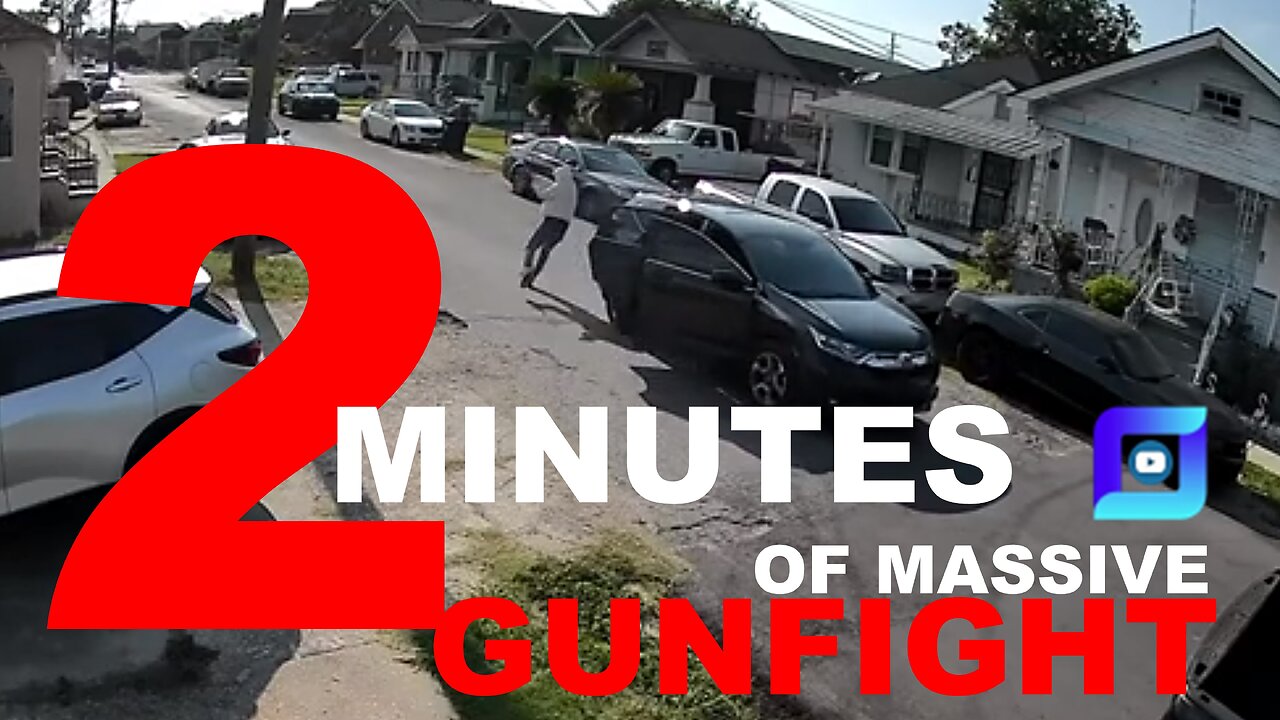Premium Only Content

2 MINUTES OF MASSIVE GUN FIGHT | MUST STOP
Across the United States, communities are grappling with a surge in gang-related violence, leaving residents feeling unsafe and authorities scrambling for effective solutions. This escalating issue demands urgent attention from policymakers and the public alike, as it poses a significant threat to public safety and the overall well-being of society.
The Prevalence of Gang Violence
Gang violence is a complex issue with deep-rooted causes, often stemming from poverty, lack of opportunities, and a sense of marginalization among young individuals. These factors can lead to individuals joining gangs, seeking a sense of belonging and protection, while also engaging in criminal activities to gain power and status.
The consequences of gang violence are far-reaching and devastating. Innocent lives are lost, families are torn apart, and communities are left scarred by fear and trauma. The economic toll is also significant, as healthcare costs, property damage, and lost productivity drain valuable resources.
Statistics Highlighting the Severity of the Issue
To fully grasp the gravity of gang-related violence in the US, consider these alarming statistics from 2023:
Gang-related homicides: According to the FBI's Uniform Crime Reporting (UCR) Program, there were an estimated 3,525 gang-related murders and non-negligent manslaughters in 2023, a 5.6% increase from 2022.
Gang membership: The National Gang Center estimates that there are approximately 75,000 active street gangs in the US, comprising over 800,000 members.
Impact on youth: Gang violence disproportionately affects young people, with nearly 80% of gang-related homicides involving victims under the age of 30.
Government Efforts to Combat Gang Violence
Recognizing the urgency of addressing gang violence, the US government has implemented various strategies to curb its spread and protect communities. These efforts include:
Law enforcement initiatives: Increased police presence in high-crime areas, targeted crackdowns on gang activity, and stricter gun control measures aim to deter and apprehend gang members.
Community-based programs: Prevention and intervention programs focus on providing youth with positive alternatives to gang involvement, such as education, job training, and mentorship opportunities.
Collaborations with social service agencies: Addressing the underlying social and economic factors that contribute to gang involvement requires collaboration between law enforcement, social service agencies, and community organizations.
Gang-related violence remains a pressing issue in the US, demanding a multifaceted approach that combines law enforcement efforts with community-based prevention and intervention strategies. By addressing the root causes of gang involvement and providing positive alternatives for at-risk youth, we can work towards creating safer and more resilient communities.
-
 LIVE
LIVE
TimcastIRL
1 hour agoTrump Orders Specialized National Guard Units To Combat Crime In Cities, Dems Furious | Timcast IRL
28,433 watching -
 LIVE
LIVE
SpartakusLIVE
3 hours ago#1 Rocket CHAMPION of Verdansk wields UNSTOPPABLE new META
409 watching -
 LIVE
LIVE
Barry Cunningham
2 hours agoPRESIDENT TRUMP MADE TODAY A VERY BAD DAY TO BE A DEMOCRAT!
7,946 watching -
 8:19
8:19
MattMorseTV
6 hours ago $0.90 earnedTrump is ACTUALLY DOING IT.
1.82K16 -
 LIVE
LIVE
ZWOGs
8 hours ago🔴LIVE IN 1440p! - Tarkov w/ Casey & crgoodw1n, Kingdom Come Deliverance, & More - Come Hang Out!
110 watching -
 1:45:02
1:45:02
Glenn Greenwald
3 hours agoIsrael Slaughters More Journalists, Hiding War Crimes; Trump's Unconstitutional Flag Burning Ban; Glenn Takes Your Questions | SYSTEM UPDATE #504
68K51 -
 LIVE
LIVE
Killerperk
24 minutes agoRoad to BF6. Come hang out #regiment #bf6
77 watching -
 LIVE
LIVE
Jokeuhl Gaming and Chat
1 hour agoDARKTIDE - Warhammer 40k w/ Nubes Bloobs and AoA
40 watching -
 LIVE
LIVE
Cripiechuccles
2 hours ago😁💚💙MOTA MONDAY WITH CRIPIE💚💙 👌SMOKING, GAMING & WATCHING FLICKS!:😁
24 watching -
 DVR
DVR
Stephen Gardner
1 hour ago🔥'Burn ALL TRUMP FLAGS’ says Tim Walz + Democrat CAUGHT rigging own election!
2192